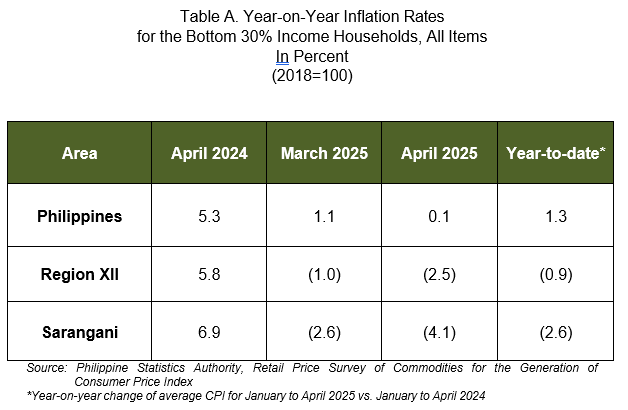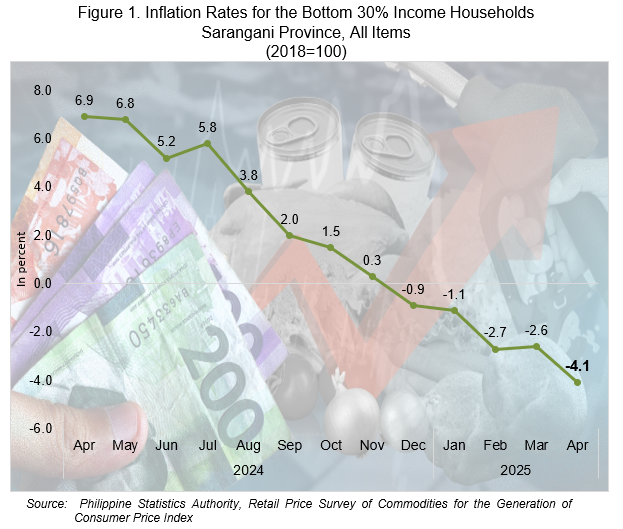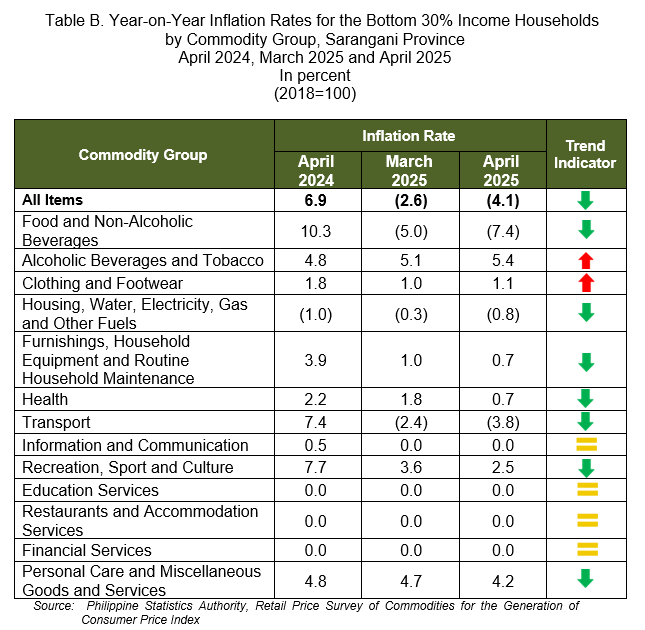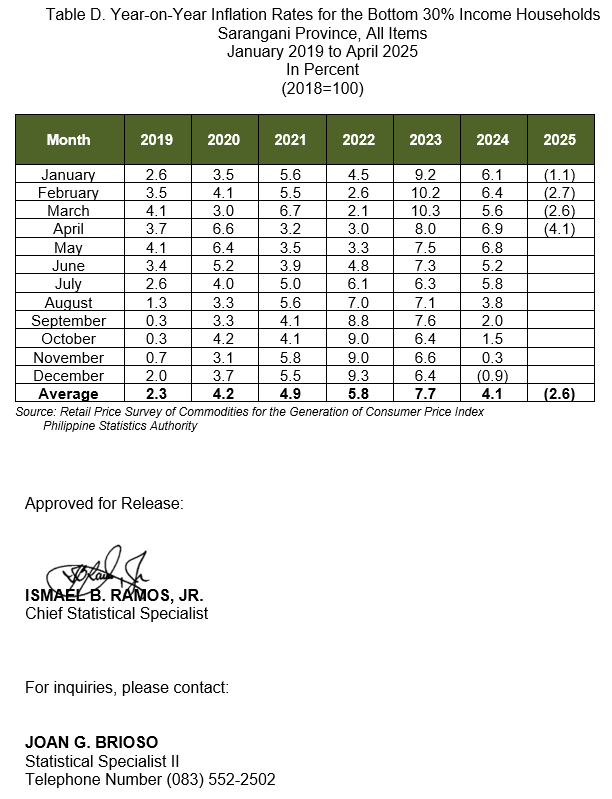
A. Sarangani Province
1. Overall Inflation
The overall inflation rate for the bottom 30% income households in Sarangani Province further declined to 4.1 percent in April 2025 from a 2.6 percent annual decrease in March 2025. In April 2024, inflation rate in the province was higher at 6.9 percent. (Figure 1, Tables A and B)

1.1 Main Drivers to the Downward Trend of the Overall Inflation (Table B)
The downtrend in the overall inflation for the bottom 30% income households in April 2025 was brought about by the faster year-on-year decrements in the following indices from their respective annual decreases in the previous month:
a) Food and non-alcoholic beverages, -7.4 percent from -5.0 percent;
b) Transport, -3.8 percent from -2.4 percent; and
c) Housing, water, electricity, gas and other fuels, -0.8 percent from -0.3 percent.
In addition, slower annual increases were observed in the following indices for the bottom 30% income households in April 2025:
a) Furnishings, household equipment and routine household maintenance, 0.7 percent from 1.0 percent;
b) Health, 0.7 percent from 1.8 percent;
c) Recreation, sport and culture, 2.5 percent from 3.6 percent; and
d) Personal care, and miscellaneous goods and services, 4.2 percent from 4.7 percent.
In contrast, higher inflation rates were observed in the indices of alcoholic beverages and tobacco at 5.4 percent during the month from 5.1 percent in the previous month; and clothing and footwear at 1.1 percent from 1.0 percent in March 2025.
Meanwhile, the following commodity groups retained their respective previous month’s inflation rates:
a) Information and communication, at zero inflation;
b) Education services, at zero inflation;
c) Restaurants and accommodation services, at zero inflation; and
d) Financial services, at zero inflation.

1.2 Main Contributors to the Overall Inflation
The following commodity groups were the top three contributors to the April 2025 overall inflation for the bottom 30% income households:
a) Food and non-alcoholic beverages with 105.6 percent share or -4.3 percentage point;
b) Transport with 5.8 percent share or -0.2 percentage point; and
c) Housing, water, electricity, gas and other fuels with 2.2 percent share or -0.1 percentage point.
2. Food Inflation
Food inflation for the bottom 30% income households at the provincial level posted a decline at 7.9 percent in April 2025 from a 5.4 percent annual drop in the previous month. In April 2024, food inflation for this particular income group was higher at 10.8 percent.
2.1 Main Drivers to the Downward Trend of the Food Inflation (Table C)
The deceleration of food inflation for the bottom 30% income households in April 2025 was mainly due to year-on-year decline in the index of vegetables, tubers, plantains, cooking bananas and pulses at 9.8 percent from a 2.2 percent annual increment in March 2025. This was followed by rice with a faster annual decrease at 22.7 percent during the month from an annual decrease at 26.6 percent in March 2025. The index of fish and other seafood posted a slower inflation rate at 0.7 percent in April 2024 from 2.2 percent in the previous month.
Furthermore, lower inflation rates were observed in the following indices in this particular income group during the month:
a) Flour, bread and other bakery products, pasta products, and other cereals, 3.3 percent from 3.5 percent;
b) Fruits and nuts, 1.6 percent from 4.4 percent; and
c) Ready-made food and other food products not elsewhere classified (n.e.c.), 3.4 percent from 4.1 percent.
Moreover, faster annual decrease was recorded in the index of suger, confectionary and desserts at 2.4 percent in April 2025 from an annual decrease of 1.9 percent March 2025.
In contrast, slower year-on-year decrease was noted in the index of corn at 22.1 percent in April 2025 from a 26.6 percent annual decrease in March 2025.
In addition, faster annual increases were observed in the indices of meat and other parts of slaughtered land animals at 4.1 percent during the month from 3.7 percent in March 2025 and milk, other dairy products and eggs at 8.5 percent in April 2025 from 7.5 percent in the previous month.
The index of oils and fats retained its previous month’s annual decrease at 3.1 percent.
2.2 Main Contributors to the Food Inflation
Food inflation contributed 107.8 percent or -4.4 percentage point to the April 2025 overall inflation for this particular income group.
Among the food groups, the top three main contributors to the food inflation during the month were:
a) Cereals and cereal products, which includes rice, corn, flour, bread and other bakery products, pasta products, and other cereals with 100.9 percent share or -8.0 percentage point;
b) Vegetables, tubers, plantains, cooking bananas and pulses with 13.6 percent share or -1.1 percentage point;
c) Sugar, confectionery and desserts with 0.9 percent share or -0.1 percentage point.



